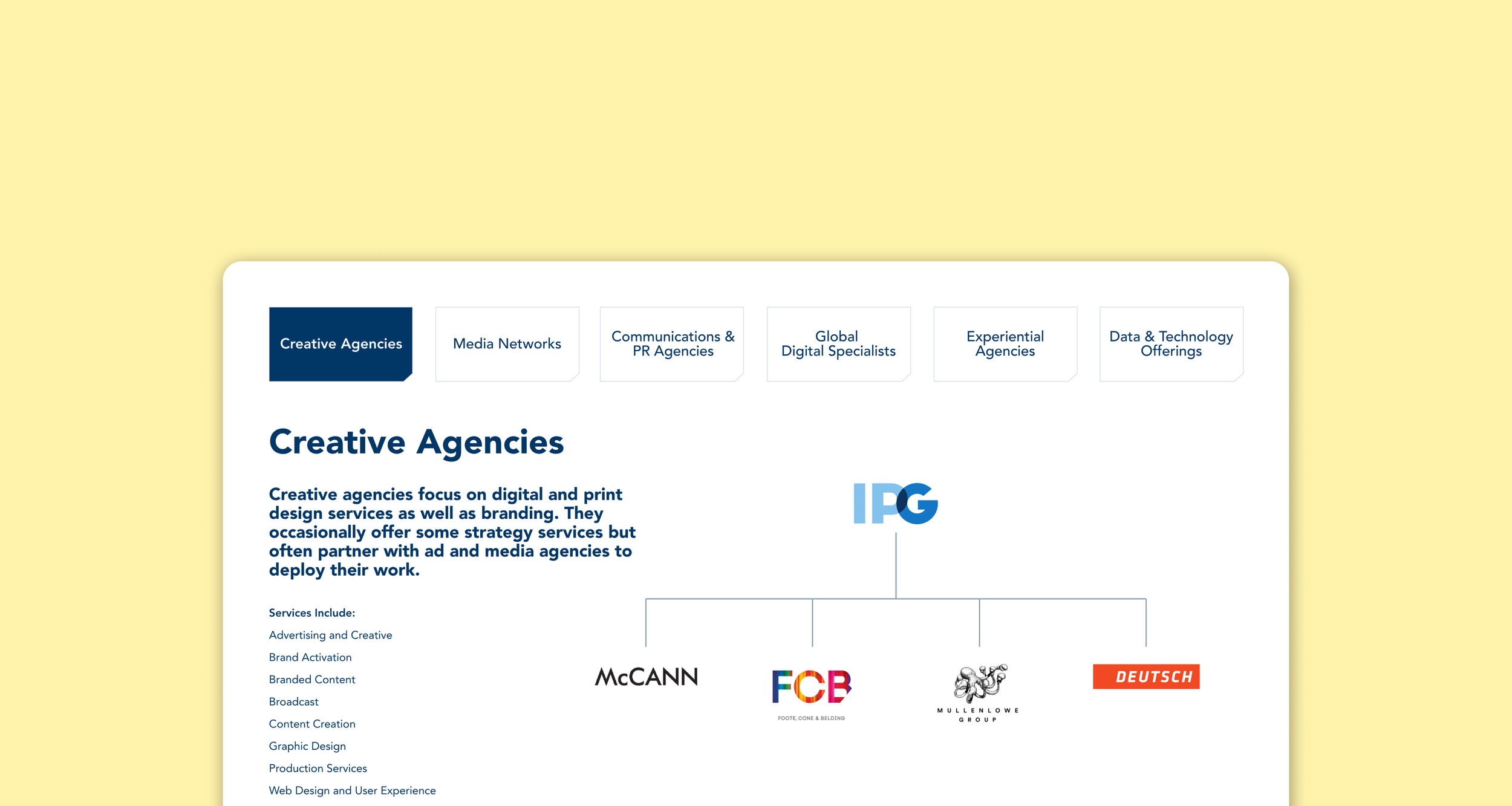
IPG Open Architecture Interactive Tool
Project Type
Personal project for IPG/Kinesso
My Role
Lead Designer
Timeline
4 months
Contribution
Research and planning
Project management
High-fidelity prototype
Tools
Adobe XD
As a new employee at Interpublic Group (IPG), it can feel overwhelming to conceptually understand and process the size, complexity and diversified business lines within the holding company. Each agency has a unique and standalone value proposition. In addition, IPG operates with open-architecture model, which integrates the best of each agency offering to create a bespoke and custom solution for our clients.
When I joined Kinesso, I saw an opportunity to create a resource that can be used to cross-train talent and maximize their understanding of the network. Ultimately, I collaborated with the Marketing, Global Learning Solutions, and Product Innovation teams to bring to life an interactive tool that visually portrays IPG’s open architecture model.
Project Goals
To create a united resource that articulates the integrated approach of IPG
To empower Kinesso talent with relevant information about the Kinesso organization and contextualize their impact on the network
DEFINING THE PROBLEM
When I was going through the hiring and onboarding process at Kinesso, I found it overwhelming to understand and process the organizational structure of IPG. I started imagining an interactive tool, similar to a family tree or web, that explained the architecture of IPG and addressed the following questions:
Where does IPG fit in within the media industry?
What are the other big companies and what makes IPG stand out?
What are the different branches of IPG?
How do all of the individual agencies work together to produce the best work for our clients and keep IPG at the top?
What role does Kinesso play in this larger network?
User Personas
The IPG Open Architecture tool will be useful for anyone working at an IPG company. This large audience can be broken down into the below categories. The product was designed with the needs of each of these audiences in mind.
New Hires: This tool will be particularly useful for new IPG employees who want to learn about the business. In order to be most successful, employees have to understand the services IPG offers, the products we use, and the how the company operates.
Existing IPG Talent: This tool will become a resource for existing IPG employees to reference when working on a new business pitch or discussing what is available for clients.
Prospective Candidates: The structure of IPG can be complex and difficult for a prospective candidate to understand. A secure version of the tool will be available to the external audience to learn about IPG, its entities, and the services they offer.
DESIGNING THE SOLUTION
To effectively manage the vast amount of information, we adopted a phased approach, beginning with a high-level overview and progressively drilling down into finer details. Our strategy was to start by mapping IPG’s position within the broader industry landscape. From there, we segmented IPG into its six key divisions, examined the secondary holding companies under its umbrella, and ultimately analyzed the individual agencies. This structured breakdown allowed for a more comprehensive and focused exploration of IPG’s organizational structure.
User Flow
Wireframes
In partnership with the Global Learning Solutions team, we integrated the first two modules into the orientation curriculum to serve as a powerful tool for new hires. Users were able to interact with the live prototypes, showcased below, to gain deeper insights, context and knowledge when they joined an IPG entity.
High-Fidelity Prototype
Part 1 - IPG and its agencies
The second section explains IPG Open Architecture with a hypothetical case study. As the user navigates the course, they’ll be walked through an OA team and the roles of each agency. We chose to create a fake client, MyBank, to avoid any confusion or concerns around client privacy.
This module is set up to visualize the different layers of the business, with McCann, UM & Initiative as front door agencies and Acxiom as the foundational data layer. As the user clicks through, the highlighted boxes describe the role of that entity and how they work together. On the left there’s a visual to give a better idea of what this looks like.
It concludes with a quote from the CEO about open architecture and how it is a fundamental aspect of the IPG philosophy and business in order to humanize it and again bring it back to the IPG story.
Part 2 - Open Architecture Case Study
This section starts by covering IPG’s position in the industry as one of the big five holding companies. The purpose of this is to provide as much context as possible, keeping in mind that this could be someone’s first introduction to the industry. Looking at this through the Kinesso lens, we are able to show what makes IPG so successful by highlighting their robust data & tech offering.
From here we get into the IPG agencies and break them down into 6 categories. Each tile gives a description of the category, some of the services these entities provide, and some of the IPG entities in this category (plus a boilerplate description for each entity).
Finally, we tie it back to the industry again just to remind the user of the context and how these entities all power IPG.



